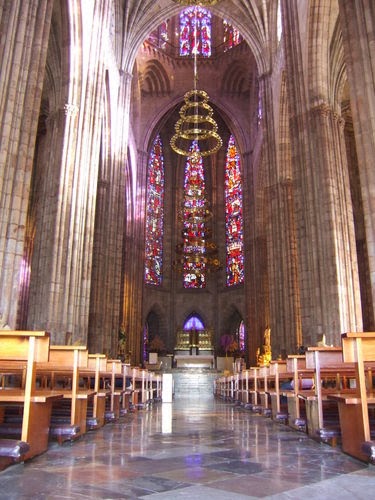
The Temple Expiatorio of the Sainted Sacrament, or more commonly referred to simply as the Expiatorio is one of the most famous catholic temples in Guadalajara. Construction started in 1897, but the temple wasn't finished until 75 years later in 1972. It was built in the Neo-Gothic style and was considered to be the best temple of its kind built in Mexico.
 The idea behind building the Expiatorio in Guadalajara was to build a temple dedicated to the Sainted Sacrament of Jesus Christ. The project was started by the Arch-Bishop Pedro Loza y Pardavé. The Arch-Bishop, along with the commission, selected Adamo Boari, a famous Italian architect, who also designed the Palacio de Bellas ARtes and the Palacio del Correo Mayor in Mexico City. However, there are some people who believe that it was really the Mexican Architect Salvador Collado that REALLY designed this beautiful building.
The idea behind building the Expiatorio in Guadalajara was to build a temple dedicated to the Sainted Sacrament of Jesus Christ. The project was started by the Arch-Bishop Pedro Loza y Pardavé. The Arch-Bishop, along with the commission, selected Adamo Boari, a famous Italian architect, who also designed the Palacio de Bellas ARtes and the Palacio del Correo Mayor in Mexico City. However, there are some people who believe that it was really the Mexican Architect Salvador Collado that REALLY designed this beautiful building.During the Mexican Revolution, the construction of the Temple Expiatorio was stalled for various reasons, because of religious persecution, the economic crisis and the workers going to war. It wasn't until 1924 that the construction of the building began once again. In this time, it was the architect Ignacio Diaz Morales that finally finished the temple in 1972.
The temple is basically made with stone as they would have made it in the Middle ages. The doors are made from a dark red hardwood usually reserved for making musical instruments, embedded with bronze figures. The tree frontal designes are made of Italian mosaics in the mosaic factory and designed by the Vatican museums Francisco Bencivenga who also oversaw their placement on the building. The Watch temple was imported from Germany. It has four faces that are lit at night and inside contain 25 bells that play 25 different tracks of both religious and popular songs including Ave Maria, the National Anthem, Las Mañanitas, Guadalajara's song, and Mexico Lindo y Querido. The cost of the clock along was about 450 thousand dollars. At 9am, 12pm and 6pm, when the bells chime, they are also accompanied by figures of the twelve apostles in the style of a coco-clock.




